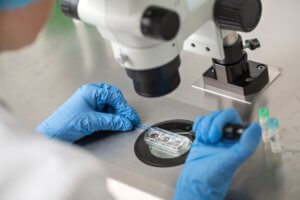What is INVOcell and how does it compare to traditional IVF?
 New in vitro fertilization technologies continue to help our patients achieve pregnancy, but it is easy to be confused with all the options to consider. In this blog we hope to clear up any confusion between INVOcell and traditional IVF.
New in vitro fertilization technologies continue to help our patients achieve pregnancy, but it is easy to be confused with all the options to consider. In this blog we hope to clear up any confusion between INVOcell and traditional IVF.
The technology involved in the treatment of infertility has rapidly advanced over the last 20 years – perhaps more than any other medical specialty. IVF success rates today are almost double what they were in 2000. This improved success is attributable to many different things, but largely due to improvements in the IVF lab. Which is why we think there are better options available to our patients than the intravaginal device INVOcell promoted as an alternative to traditional IVF by other physicians.
Initially designed for use in under-developed countries without access to a full-service IVF lab, INVOcell is a thick plastic cylinder that securely stores eggs and sperm to fertilize and incubate inside the vagina rather than in the IVF lab. After 5 days in the vagina, an embryologist opens the container and determines if any embryos survived and could then be transferred to the uterus.
The idea is that the vagina is a “natural” incubator and provides a similar environment to that in the IVF lab. In theory, avoiding the high cost of the lab should translate into financial savings for the patient.
INVOcell compared to traditional IVF yields less success
While it is slightly less expensive to attempt conception using an intravaginal device, the downside is that this procedure results in significantly fewer embryos compared with traditional IVF. This means a higher percentage of started IVF cycles do not result in a viable embryo for transfer and the couple must consider trying again, thereby erasing any cost savings.
Additionally, since the progress of embryo culture cannot be monitored while the device is in the vagina, any information about specific embryo development is lost. Ideally, we want IVF to shed more light on the cause of infertility, not less.
Finally, pregnancy rates per transfer with an intravaginal device are reportedly 30% compared to pregnancy rates with contemporary IVF techniques, especially among young women, as high as 60-70% (when using preimplantation genetic testing). For most couples experiencing infertility, this makes traditional IVF more powerful and cost-effective.
Minimal stimulation cycles are an alternative to intravaginal devices
Since the cost savings is the most attractive feature of INVOcell, Fertility Answers offers the similarly priced but more effective option of Minimal Stimulation IVF. “Mini IVF” uses much less medication but still gives our patients the advantage of the controlled physiologic conditions of the IVF lab. With less medication, we retrieve fewer eggs and create fewer embryos, but we still have a very good chance of at least one embryo for transfer.
Mini IVF is also especially attractive for couples who don’t want extra embryos to cryopreserve since less medication will “wake up” less eggs to fertilize. And, Mini IVF has respectable success rates of 35-45% compared to published INVOcell rates of 30%.
Need more information about your treatment options? We are happy to discuss our lab’s philosophy and techniques with any patient to help explain our position on these issues. Contact us.



